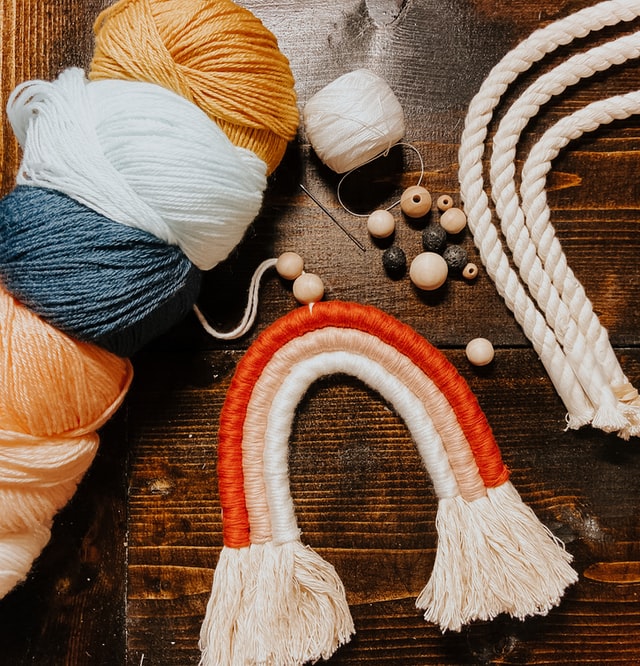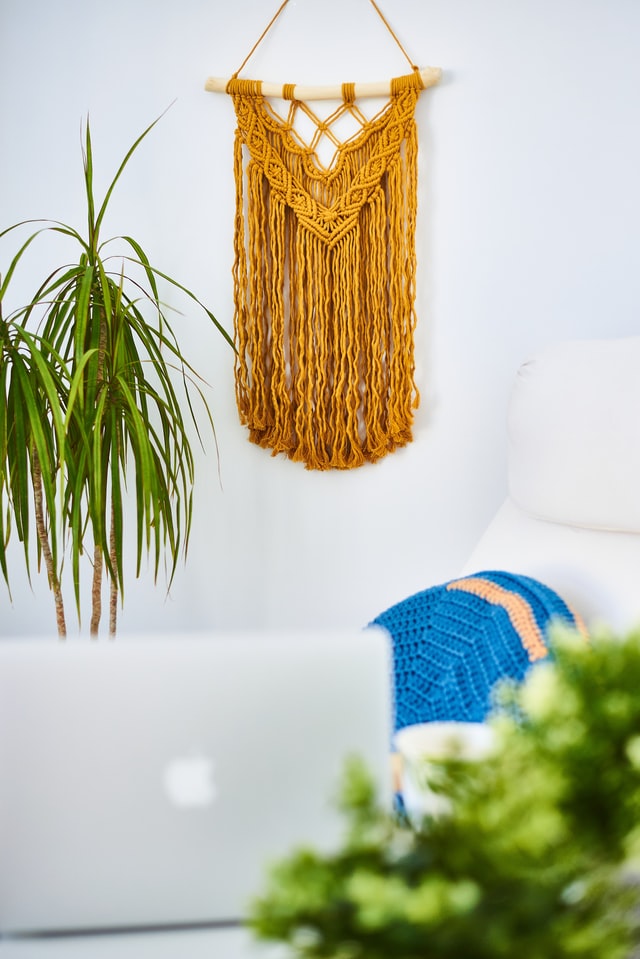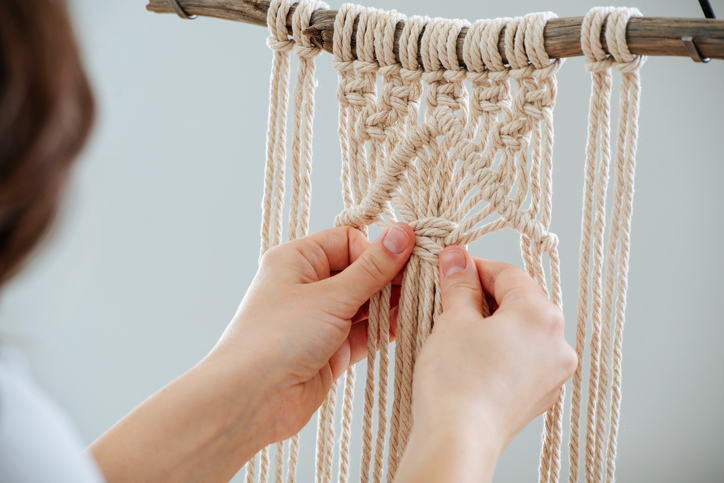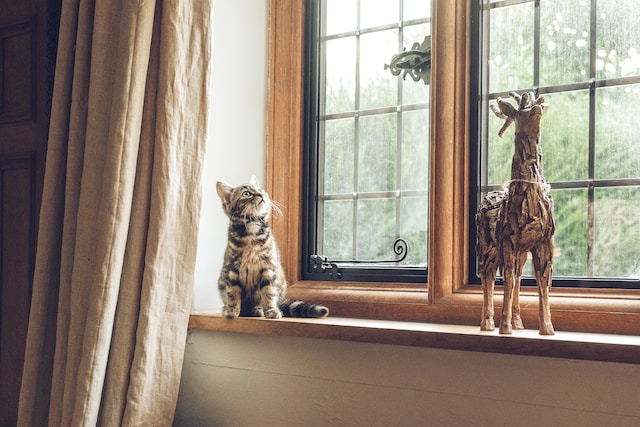Macrame is a type of textile that’s formed with knotting rather than knitting or weaving. An ancient practice, macrame may have gone in and out of fashion over the centuries, but it’s undoubtedly enjoying a trend-right comeback these days. While stores are filled with a wide range of macrame products ranging from wall hangings to vests, many people choose to learn this age-old fiber craft and create their clothing or home decor accents. Here, we’ll explore what this textile craft is and how to get started.
What Is Macrame?
Macrame is formed into textile garments, accessories, and items by knotting fibers together. Macrame artists and crafters rely on a wide range of materials to create macrame. Some of the most common materials include hemp, jute, cotton twine, linen, yarn, and leather. These fibers twist into cords which then fashion into macrame items. In some cases, crafters might use beads or shells to adorn macrame items, as with jewelry.
The History of Macrame
Historians believe some of the earliest examples of macrame date to the time of the ancient Babylonian and Assyrian civilizations. Stone carvings of the time depict macrame knots and plaits in carvings. People of that time wore clothing with macrame-style fringe or adorned their homes with macrame accents. Later, Arab weavers created decorative fringes for towels, veils, and other garments using macrame knots. In North Africa, macrame was used to ward off flies from horses and camels. Eventually, the practice of macrame spread with the Moors into Europe, where even royalty wore macrame-style accessories.
Macrame was especially popular during the Victorian period. Victorian tablecloths, draperies, and other household items featured macrame fringe and decorative knot work. Sewists used macrame techniques to create elaborate trims for dresses and bed linens. Costume books of the era showcase a wide range of macrame artistry, demonstrating just how far the practice had evolved in complexity and skill.
The practice reached remarkable heights with the macrame artistry of British and American sailors. Already skilled in knot work, as a matter of course in their line of work, 18th and 19th-century sailors crafted hammocks, belts, and other items with macrame. They’d often trade these items for other goods in ports as far off as China.
Over the decades since, macrame fell in and out of style. It enjoyed a tremendous resurgence in popularity during the 1970s. Now, this centuries’ old textile is in vogue again. You can learn how to do macrame to create a wide assortment of items.
Knots, Patterns, and Techniques (DIY Macrame)

If you want to start making macrame items, it helps to find some books on the topic to see how the knots are formed first hand. Many online macrame tutorials will help you learn basic knots, techniques, and patterns, as well as more elaborate ones. We’ll cover some of the basics here so you can get started:
Knots
There are a series of basic knots that are commonplace in macrame. These knots are:
- Larkshead knot
- Half knot
- Square knot
- Gathering knot
- Left-facing knot
- Right-facing knot
- Spiral stitches
- Overhand knot
- Straight clove hitch
- Diagonal clove hitch
Many projects involve multiple types of knots. Moving from one type to another involves various techniques. Depending on the patterns you choose, you may use one or two knots or many different kinds.
Patterns
Even some macrame items that seem incredibly complex begin with a simple pattern, involving just a few types of basic knots. There are many macrame patterns available online for free or for purchase. There are lots of ways to make both decorative and functional things. From small keychains to large wall hangings, you can find patterns to help you practice macrame crafting.
Techniques
Macrame involves many repetitive techniques. The most important techniques involve the knots—learning how to begin them and complete them. Many beginners find it helpful to start new macrame projects using a dowel, frame, or another object to provide support. Some techniques you should plan to learn include:
- How to create fringing
- How to transition from one-knot style to another
- How to tighten knots
- Finishing techniques
The key to successful macrame projects is to blend knots and techniques to complete your projects. By starting simple, you can build on your skills to create more elaborate projects.
DIY Macrame: Set Up Your Space
You’ll need to gather some supplies and set up an area to work once you’re ready to get started. Fortunately, you don’t need a lot. The most helpful supply, of course, is your pattern and how-to guide so you can learn how to achieve each different type of knot. The knots used in macrame often involve multiple steps. A step-by-step guide with pictures is the easiest way to learn how to form the knots used in macrame. You can purchase these guides from bookstores that sell craft books or even find them online.
Macrame Materials
Before beginning your macrame projects, you’ll need to gather the following supplies:
- Rope
- Scissors
- Measuring tape
- Fabric glue
- Dowels
- Wooden or glass beads (optional)
- Wood rings (optional)
Although there are macrame kits available for specific projects, you can easily purchase your macrame rope. For instance, macrame rope may be formed from cotton, jute, leather, or even wool. You can buy macrame cords from your local craft store or find a wide selection online. The fabric glue is an optional item, but if you’re creating a chair or plant hanger, you’ll want to ensure that your completed product is durable. Placing a dot of fabric glue within the knot as you start will help you create a more robust object. This may not be necessary for strictly decorative macrame crafts like wall hangings.
Macrame experts suggest using a soft cotton rope because it’s pliable and easy to work with. The cords are sold in different sizes. Thinner cords are ideal for jewelry projects. Some crafters use yarn macrame, but it can be challenging to work with because it doesn’t have the same springy quality than cotton or jute rope offers. Sometimes macrame crafters also add ‘found’ objects to their macrame projects; these might be seashells or a piece of driftwood. You can also add functional items to your macrame projects, such as a board (for shelving) or a keychain.
Set Up Your Space
You’ll need a flat surface for your macrame setup so you can carefully layout, measure, and cut your macrame cord. Your workspace should include comfortable seating and plenty of good light. The types of projects you choose will necessarily cause you to alter your space. Flat projects can be created on a flat surface like a table or workbench. However, if you’re making a vertical item, you may wish to hang your project over the back of a door or chair to work on it.
Macrame Decor

Today, you can find DIY kits to make a wide range of macrame household decor, or you can purchase these items ready-made. Because macrame is back in style, it’s sold in a wide range of stores. You can find everything from macrame plant holders to wall decor. Fiber art decor is also a fixture at many big-box stores that sell household accessories and decorative items.
While wall hangings are incredibly trendy right now, remember that you can also buy essentially functional macrame items such as curtains, table runners, hammocks, chairs, and patio umbrellas. Macrame jewelry like bracelets and necklaces are widely available at stores and outdoor fairs and festivals where handicrafts are sold.
Decorating with Macrame
You can add macrame to your home in exciting ways. Need a room divider? Consider a decorative macrame curtain to suspend from your ceiling. This is an excellent project for dividing a bedroom between two siblings. Macrame wall hangings can also be hung anywhere you’d place the artwork. Look for wall hangings with lights strewn into their designs for added visual appeal.
You can also hang macrame curtains in windows or adorn chair backs with macrame covers. Macrame items such as throw pillows, hanging shelves, jar covers, plant hangers, photo frames, mirror frames, and tablecloths are widely available. Many commercial macrame items sold today are made with neutral-colored cords such as ivory, gray, and beige. However, you can craft macrame items made with any colored cords you prefer. You can even dye your rope to use for crafting.
Macrame is an ancient practice enjoying a resurgence in popularity today among shoppers of household decor and do-it-yourselfers. Macrame can help you improve the strength and skill of your fingers with its repetitive knotting techniques. This is also a fun craft to enjoy with friends or another family member. Use this guide to help you get started with this textile craft today.




